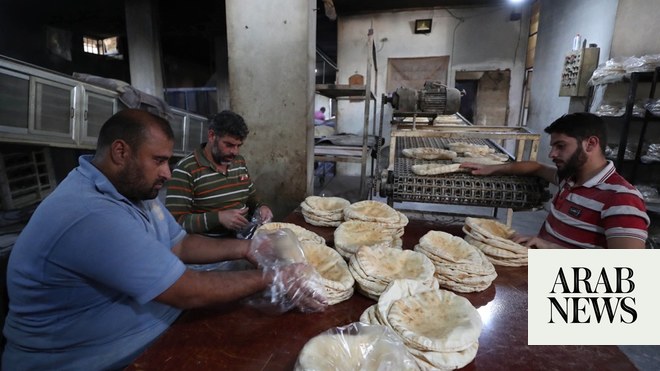
Import-reliant region has felt the pinch since Russia withdrew from the Black Sea grain deal and India banned rice exports
Govts. urged to boost food system resilience by diversifying import sources, increasing domestic production
TUNIS: As the Israel-Palestine conflict once again flares up, threatening to plunge the Middle East into a new crisis, it does not mean that the other serious problems plaguing the Middle East and North Africa region are petering out.
Many low- and middle-income Arab economies have been facing worsening food security conditions in recent months, after Russia withdrew from the Black Sea Grain Initiative and India banned the export of white rice and sugar. Among the most vulnerable countries are Tunisia, Libya, Lebanon, Iraq and Egypt, to say nothing of conflict-torn Syria, Sudan and Yemen.
Russia’s exit in July from a grain-export deal announced 12 months earlier has disrupted global grain supplies in general and wheat markets in particular. At the same time, global rice prices have skyrocketed since India’s decision, also in July, to halt exports of non-basmati varieties.
Egypt and Lebanon, heavily reliant on imported rice and wheat, are now grappling with food-financing challenges, while Sudan, which was already battling hunger and civil conflict, is in no position to import costly foodstuffs.
In the face of these challenges, many are asking what food-insecure Arab countries ought to be doing to help insulate themselves against the effects of future supply-chain shocks, to help keep prices affordable for their populations, and potentially localize more of their food production.
“By reducing reliance on a single source, these nations can mitigate the risks of abrupt disruptions, similar to those witnessed in the Ukraine-Russia conflict,” Adam Vinaman Yao, deputy representative of the UN’s Food and Agriculture Organization in Sudan, told Arab News
Prior to the conflict, which began in February, 2022, Russia and Ukraine were jointly responsible for almost a third of the world’s wheat and barley production. Russia’s invasion resulted in the blockade of Black Sea ports, however, raising fears of imminent shortages on the world market that would potentially hit import-reliant developing nations the hardest.
The Black Sea Grain Initiative, brokered by the UN and Turkiye in July 2022, played a pivotal role in facilitating the continued export of millions of tons of grain from Ukraine to global markets despite the conflict, via the Bosphorus Strait. Approximately a third of the grain that traversed the Black Sea under the deal was destined for Egypt, Libya, Israel, Tunisia, Algeria, Turkiye and Iran.
The deal therefore offered some respite. However, just a year after it came into effect, Russia abruptly announced it was withdrawing from the agreement.
Lebanon, which has been in the throes of a crippling economic crisis since 2019, and Yemen, which has been brought to the brink of famine as a result of a nine-year civil war, were especially vulnerable to the disruption.
The UN World Food Program, which provides a lifeline for millions of people caught up in humanitarian disasters worldwide, particularly in the drought-stricken Horn of Africa, was also significantly affected by the collapse of the grain deal.
As of July this year, about 80 percent of the WFP’s grain stock originated in Ukraine, up from about 50 percent before the war.
The Middle East and North Africa region, much of which was already reeling from soaring public debt, high inflation and steady currency depreciation, now faces the additional threat of soaring food prices. The collapse of the grain deal merely intensified the supply challenges and price pressures such nations were already confronting.
Countries such as Lebanon, Egypt, Syria and Iran, which have experienced sharp currency devaluations leading to triple-digit food-price inflation, are now at even greater risk. In fact, the number of food-insecure people across the MENA region has surged by 20 percent in the past three years as a result of conflicts and climate-related challenges, such as drought.
Egypt, projected to be the world’s leading wheat importer in 2023-24, expressed strong disapproval of Russia’s decision to withdraw from the grain deal. Egyptian authorities heavily subsidize the price of bread, and so the country is highly susceptible to food-price fluctuations.
Egyptian President Abdel Fattah El-Sisi’s decision to personally attend the Russia-Africa Summit in St. Petersburg in July gave some indication of how seriously his government is taking the issue of the grain deal.
“Collaborations between Ukraine and Egypt for direct corn supply are on the horizon, as Ukrainian corn holds a unique position in the market, being geographically closer than alternatives in Brazil and Argentina,” Pavlo Martyshev, a Kyiv School of Economics expert in food markets, told Arab News.
The collapse of the deal was not solely the result of geopolitical maneuverings. Russia claimed that certain aspects of the agreement, particularly those relating to its own food exports, had not been implemented, and that Western sanctions were indirectly affecting its grain exports.
Moscow’s demands for its agreement to resume the deal, including the readmission of the Russian Agricultural Bank to the SWIFT international payments system and the resumption of exports of agricultural machinery, have thrown up further roadblocks.
However, Moscow’s claim that Russian farmers have had a raw deal compared with their Ukranian counterparts does not stand up to scrutiny.
Figures from the UN’s Black Sea Grain Initiative Joint Coordination Center, which facilitated the implementation of the agreement, reveal a decline in Ukrainian grain exports since the deal was signed in 2022, and particularly during May and June this year. Ukrainian production also suffered a significant blow as a result of the war, decreasing by between 35 and 40 percent.
In contrast, Russian wheat exports surged to historic highs in 2022 and 2023, thanks to a record harvest and substantial wheat stocks. However, this abundance did not ease the pressure on those nations dependent on the import of Black Sea grain.
FASTFACTS
• 783m People across the world who do not have enough food.
• 60% Cut in World Food Programme food aid recipients since June due to funding shortfalls.
• 60% World’s hungry living in zones affected by conflict.
• 8o% Hunger crises of which conflict is the main driver.
Russia has given the UN three months to implement terms to facilitate its agricultural exports, a move that could help stabilize the situation. Amid a Ukrainian counteroffensive, however, efforts to address this issue require careful diplomacy.
Around the same time as Russia withdrew from the grain deal, India’s government announced its decision to ban the export of several varieties of rice, to ensure sufficient supplies were available at home. The decision — prompted by rising domestic food prices, stubborn inflation and fear of shortage due to El Nino disruption — pushed up prices on the global market.
Although the ban does not include the popular basmati variety, which is a staple of Gulf dinner tables, it nevertheless triggered an increase in the prices of all rice varieties, adding to the vulnerabilities of import-reliant economies in the Middle East and Africa. By the middle of August, global rice prices had jumped 15-25 percent.
The UAE imports almost 90 percent of its food, so it is especially vulnerable to fluctuations in global prices. According to Reuters data, the nation was among the top 10 importers of non-basmati rice from India in 2020, buying almost 346,000 tons. Saudi Arabia, Iraq, Iran, Yemen, Kuwait, Oman, Qatar, the UK and the US also feature on the list of the top 10 importers.
Other countries that were likely to feel the squeeze as a result of India’s export ban include African nations such as Benin. But even large economies such as China were not insulated from the price shock, even though it is a major rice producer in its own right.
Arab countries that have suffered the most from higher rice prices include Egypt, Algeria and Sudan, all of which were already facing economic headwinds and footing inflated wheat import bills.
In Sudan’s case, a deadly feud between two military leaders that has been raging since April 15 has compounded the woes of a population ravaged by hunger and malnutrition.
With no end to conflicts, fuel-price rises and climate crisis in sight, experts say that besides diversifying sources of food imports, Arab countries should try to improve the resilience of their food systems by promoting domestic production, including greater investment in new agricultural technologies and innovations closer to the domestic market.
“Implementing low-cost modern irrigation and water-harvesting techniques, exploring alternative energy sources, and building resilience in dry-land agriculture can help these nations reduce their reliance on costly imports,” said Yao.
However, many Arab countries, including Egypt, Iraq, Syria and Jordan, are in no position to meet their own national demands for wheat and rice, as they lack the necessary water resources.
Homegrown grain does not meet even half of Egypt’s demand, particularly for wheat and corn. The country imports more than 10 million tons of wheat — mostly from Russia and Ukraine — and that amount is expected to grow.
Local wheat production is expected to remain at 9.8 million tons, and consumption to increase by 2 percent to 20.5 million tons in 2023-2024, according to a US Department of Agriculture report published in April.
Habib ben Moussa, an expert in the environment and sustainable development from Tunisia, nevertheless believes that bolstering domestic food production and implementing sustainable farming practices could aid diversification and improve the resilience of Arab food systems.
“This approach encourages the use of native seeds adapted to local conditions, reducing dependence on imported seeds that may not thrive in the region, while promoting sustainable production and consumption not only conserves resources but also enhances resilience in agriculture,” Moussa told Arab News.
Over the past decade, Saudi Arabia has made significant strides in improving its food security, including the launch of initiatives to diversify and localize food sources, thereby reducing its dependence on imports.
This involves significant investment in agri-tech and the introduction of modern agricultural techniques to enhance local production, minimize water wastage, and boost efficiency in the agricultural sector.
The significance of these efforts was underscored when Saudi Arabia’s General Authority for Statistics reported in September the country had achieved self-sufficiency in the production of dates, dairy products and eggs.
The war in Ukraine and Russia’s withdrawal from the grain deal, combined with India’s swing toward protectionist trade policies, has laid bare the need for food-insecure nations to rethink and overhaul their food systems and supply chains.
“Promoting domestic food production, diversifying food-import sources, embracing local seed varieties, and adopting sustainable agricultural practices are key steps,” Yao said.
“These measures can help reduce vulnerability to global grain-market fluctuations and ensure a stable food supply for their populations.”
The hope is that once the dust settles on the latest Middle East political crisis, the region’s daunting food-security challenge will once again get the attention it deserves.












